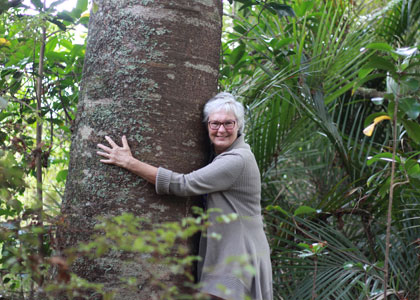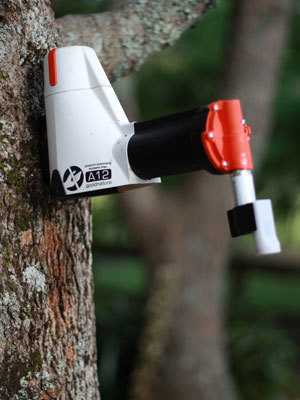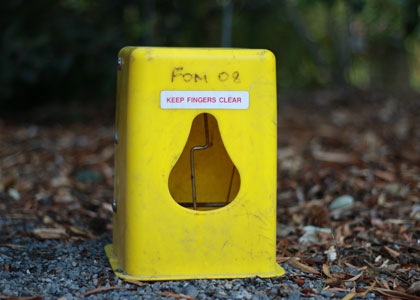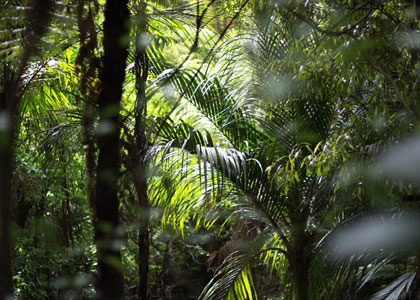
Times reporter Scott Yeoman gets a tour of a privately-owned property near Whitford and looks at what’s behind the stunning re-generation of native flora and fauna there.
We walk down a slight grassy decline, away from the house and garden and towards 4.5 acres of native bush, just as a plump kereru flies overhead, the noisy beating of its wings causing us to cast our eyes upwards and follow its flight path.
The green, bronze and white blur of the native pigeon crossing the clearing is soon replaced by several wheeling tui and as we get closer to the bush, more kereru and tui fly low above us.
The range and level of birdsong, so close to suburbia, has me in a daze and seeing the native birds flying all around us is a delight.
“Our reward is the bush and birds – seeing the growth here and the amount of birds we have coming in,” the owner of this paradise-like property says.
She’s giving a tour of her land, which sits on the remnants of the original Hunua Forest near Whitford, to the Times and Sally Barclay – a member of the Friends of Mangemangeroa (FOM) Society.
The FOM is a local, environmentally-minded group who work with Auckland Council to maintain and restore the coastal forest along the Mangemangeroa Estuary on Somerville Road in Howick.
They raise and plant between 6000-8000 plants a year in the Mangemangeroa Reserve and there are about 300 volunteers involved.
The woman showing us around – who wants to remain anonymous – is one of 15 private landowners who Ms Barclay has recruited to help the FOM tackle the issue of possums and other pests.
“It stemmed from the fact that there was a noticeable decline in bird song in the Reserve indicating a decline in their food, the culprits were these jolly possums,” Ms Barclay explains.
“We had carmine rata, a rare species, growing and it didn’t flower because the possums had chewed off the flowering buds.
“So we were aware that the possums were eating the flowering plants within the Reserve, which also means of course that they were going to be getting the birds eggs.”
And so a long-term community pest control project was set up by Ms Barclay.
Last year, with funding from the Howick Local Board, 15 Timms traps and five A12 self-resetting traps for possum killing – as well as $400 worth of rat bait and boxes funded by The Warehouse Botany – were issued to landowners within the Mangemangeroa Valley.

Ms Barclay says Auckland Council was setting bait once a month in the Reserve but its records showed that areas of possum invasion were not being fully addressed by the pest control programmes.
“Possums are grazers and move over considerable distances to feed,” the former high school biology teacher says.
“Thus the Friends of Mangemangeroa felt that private landowners needed to be approached to see if they would agree to set traps on their land.”
With a lot of private land around the Reserve, the FOM hope the private landowners will help control possums and other pests and monitor catch numbers, thus making it possible to know what’s happening in the area over a long period of time.
There are 15 landowners who now set and monitor traps in areas adjacent to the Reserve or on land where there is known possum and pest activity.
The landowner giving us a tour of her property, which has 4.5 acres of native bush and borders a further 5.5 acres, is clearly passionate about nature, wildlife and New Zealand.
She had been trapping possums for some time when the FOM pest control project came along, but the group has supplied her with more advanced possum traps and rat traps to continue and increase her good work.
The woman says she and her husband get “personal pleasure from doing [their] little bit to keep the bush pristine”.
She acknowledges that it is an effort – “you have to keep monitoring things” – but says the noticeable increase in birdlife and native bush re-growth shows it is working.

When the woman and her husband moved onto the property eight years ago, her two Timms traps were catching two possums a night.
Now she might go weeks without catching one, she says, and her dedicated and constant trap-setting, despite the decline in victims, means even roaming possums don’t last long on her section of land.
She proudly names and points out the various native plant species flourishing there as we climb over a fence separating the clearing and walk down through the bush.
There are five kauri trees, rewarewa, puriri, rimu, northern rata, various rare native ferns, carmine rata, cabbage trees – just to name a few.
On top of the pest trapping, the woman also plants food trees for the birds and controls invasive weed species as they pop up.
All of this has helped bring about the “reward” of increased native bush growth and resident birdlife.
She believes the kereru are nesting somewhere high in the trees and the now-familiar blur of green, bronze and white and the constant clamour of heavy wings above us as we walk through the bush suggests she is probably right.
She also says she now sees “masses” of tui and fantail and can hear morepork in the bush and in her garden all night long.

While the FOM hope to also see increased birdlife in the Mangemangeroa Reserve over time, there is a bigger objective, a more important one, to all of this pest control work.
“What grows best on the land are the native trees, we know that. We also know that the native trees act as filters to keep the water that goes into the harbour in a better state, this helps to ensure a more sustainable future,” Ms Barclay says.
She says if you have native trees, then you have to ensure that they are able to grow and re-generate.
“That re-growth and re-generation is stopped or reduced by the introduced pests – the possum, the stoat, the rat.”
While 1080 poison has been extremely successful in killing possums in larger areas, Ms Barclay says, “there is no way we want to see 1080 put around locally in the Howick area”.
She says there are other means of controlling possum and pest numbers and one of these is having local landowners help reduce the number of introduced pests.
“By getting the community involved, we’re hoping to see further re-generation of that native bush naturally and as a consequence of that an increase in the birdlife. If you’ve got pest free bush, you’ve got the birds.”
As we walk back up the clearing towards the landowner’s house and garden, I can see skittish fantails weaving around the trees and ferns to my left and right.
At the bottom of the glade behind us, the five kauri trees stand strong, climbing above the bush canopy which, as the sun breaks through, shines with more than a few shades of New Zealand green.
—
Want to help?
To get involved in the Friends of Mangemangeroa Society community pest control initiative, you can phone Sally Barclay on 09 534 6196 or email her at: sallyannbarclay@gmail.com.








